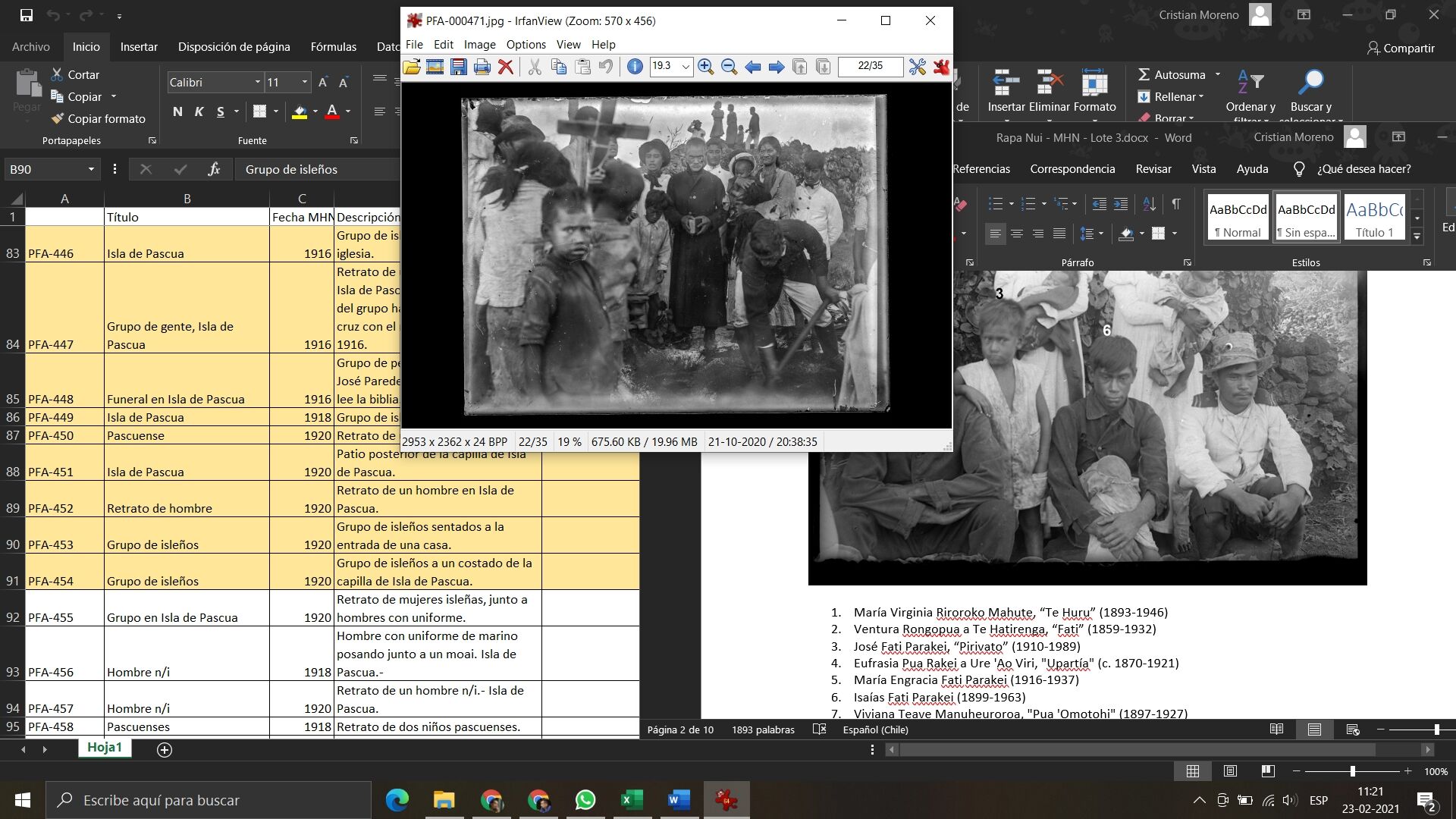26 Feb 2021 | Cristián Moreno Pakarati
Rapanui people in historical photographs: The quest for complete identification
Over the last decade, I have been fascinated by old photographs from Rapa Nui (aka “Easter Island”) as historical documents. Not only because they show the drastic changes that the island has gone through since the time of the first photo collection (stemming from the USS Mohican expedition in 1886 and remaining to this day), but also because they are marked by a paradox. The photographs of archaeological sites represent the overwhelming majority of the image corpus of Rapa Nui, and most are quite redundant. The large half-buried moai at the slopes of Rano Raraku have been (and still are) photographed so often that one has seen the same photo from the same angle hundreds of times. However, the much scarcer photographs of Rapanui people are always unique. Unlike the moai, people grow up, get older, change their physical features relatively fast and eventually pass away.
For the Rapanui people, photography was an alien technology until quite recently. They had no access to cameras, films and the chemicals needed for their development until the 1970s. And even then, they were available only to a very few. We have no idea what kind of images the Rapanui people would have considered relevant to preserve for posterity before that time. Times have changed, globalization has reached the island, and now, every single person owning a cellphone, owns a camera, too. Future anthropologists and historians will have no problem exploring the remains of the current internet, hard drives, data centers or other technologies to see fully identified people and what they decided to share over social media.
But when we work with historical photographs (1886–1925), we see Rapanui people through a foreign lens. In most cases, a lens that treats them as “curiosities” or strange “natives”, exploiting the exoticism, remoteness, and inaccessibility of the islanders to the reader or researcher. That is why the individuals in these pictures were rarely identified by their name. Most of the time, they were presented as “Easter Island native”, “kanaka from Easter Island” or “old islander and his family”, whereas Westerners living on Rapa Nui were always identified by name, role, nationality, etc. The audiences to whom these articles or books were directed, identified with them, a Westerner living on an exotic island, but not at all with the Indigenous population. That is also the reason why these photographs have not yet fascinated many Rapanui as much as they fascinate me. How can we make these photographs relevant to the Rapanui people of the 21st century? Database and workflow of identifying individuals in historical photographs. Photo: Cristián Moreno Pakarati, 2021.The path was shown by Dr. Grant McCall who, in the 1970s and 1980s, worked with the collections of the Bernice Pauahi Bishop Museum, which houses photographs taken by English settler Henry Percival Edmunds between 1910 and 1929. McCall worked with his Rapanui teachers and collaborators, Victoria Rapahango, José Fati and León Tuki, among others, to identify most of the people who appear in that massive collection, producing a document called “Las Fundaciones de Rapa Nui”. That was the starting point. Using Rapahango, Fati and Tuki’s information (via McCall) as a foundation, we have greatly expanded that work. Using my genealogical database, several censuses from that era, information from other archives and photo collections, and extensive cross referencing, I aim to identify every single person alive in the decade of 1910 and seen in these photos, and connect them genealogically to the current generation. This way we can give these faces their identities back, bringing their history to the surface and making this material relevant to the young Rapanui generation. We are currently working with a dozen archives (especially the Chilean Museo Histórico Nacional) and hope to launch a public database by 2022.
Database and workflow of identifying individuals in historical photographs. Photo: Cristián Moreno Pakarati, 2021.The path was shown by Dr. Grant McCall who, in the 1970s and 1980s, worked with the collections of the Bernice Pauahi Bishop Museum, which houses photographs taken by English settler Henry Percival Edmunds between 1910 and 1929. McCall worked with his Rapanui teachers and collaborators, Victoria Rapahango, José Fati and León Tuki, among others, to identify most of the people who appear in that massive collection, producing a document called “Las Fundaciones de Rapa Nui”. That was the starting point. Using Rapahango, Fati and Tuki’s information (via McCall) as a foundation, we have greatly expanded that work. Using my genealogical database, several censuses from that era, information from other archives and photo collections, and extensive cross referencing, I aim to identify every single person alive in the decade of 1910 and seen in these photos, and connect them genealogically to the current generation. This way we can give these faces their identities back, bringing their history to the surface and making this material relevant to the young Rapanui generation. We are currently working with a dozen archives (especially the Chilean Museo Histórico Nacional) and hope to launch a public database by 2022.
For more information on Cristián Moreno Pakarati’s work, see the Recollecting Rapa Nui project and visit the Rapanui Pioneers Society on the web, on Facebook and on Twitter.

